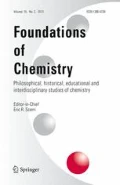Notes
Some years ago the same author wrote What is this thing called science? an introduction to philosophy of science for students not majoring in philosophy.
Numbers in parentheses indicate page-numbers in the book under review.
When considering the discussion of chemical interaction in Aristotle’s Generation and Corruption, Chalmers correctly uses “combination” or “mixt” as translations of the Greek word that is transliterated mixis. Present-day philosophers often erroneously translate this Greek word as “mixture,” even though the English word mixture has a well-defined meaning in modern chemistry—a meaning that is quite different from what Aristotle meant by mixis.
Newman (2006).
E.g., Leclerc (1972).
In A History of Chemistry, (Cambridge, MA: Harvard University Press, 1996) Bernadette Bensaude-Vincent and Isabelle Stengers discuss how such developments influenced the rise of institutions to provide education in chemistry, which also functioned as centers of research.
E.g., Klein and Lefevre (2007).
Chalmers argues that the kinetic theory was not fully established until Perrin’s early twentieth-century experiments on Brownian motion.
Jardine (2003) at pp. 127–128.
Hugh Trevor-Roper (2010). Chapter 11 reprints the “Introduction” to Thomas B. Macaulay, The History of England, edited by Hugh Trevor-Roper (New York: Washington Square Press, 1968).
Ivor Leclerc, op. cit., p. 35.
In its primary meaning, that term refers to any specific individual entity.
Chalmers employs the modern understanding of the word matter in periods where such usage is anachronistic. Few of the investigators that Chalmers considers would have considered themselves as mainly interested in “matter-theory” as Chalmers presumes. The nineteen-century organic chemists that Chalmers regards so highly had more interesting specifically-chemical concerns—including making expensive and rare stuff from cheap and available materials.
d’Espagnat (2006).
E.g., Noble (2006).
References
d’Espagnat, B.: On Physics and Philosophy. Princeton University Press, Princeton (2006) (Section 3-3-7)
Jardine, N.: Whigs and stories: Herbert Butterfield and the historiography of science. Hist Sci 41, 125–140 (2003)
Klein, U., Lefevre, W.: Materials in Eighteenth-century Science: A Historical Ontology. MIT Press, Cambridge, MA (2007)
Leclerc, I.: The Nature of Physical Existence. Humanities Press, New York (1972)
Newman, W.R.: Atoms and Alchemy: Chemistry and the Experimental Origins of the Scientific Revolution. The University of Chicago Press, Chicago (2006)
Noble, D.: The Music of Life: Biology Beyond the Genome. Oxford University Press, Oxford (2006)
Trevor-Roper, H.: History and the Enlightenment, p. 211. Yale University Press, New Haven (2010)
Author information
Authors and Affiliations
Corresponding author
Rights and permissions
About this article
Cite this article
Earley, J.E. Alan Chalmers: The scientist’s atom and the philosopher’s stone: how science succeeded and philosophy failed to gain knowledge of atoms. Found Chem 13, 79–83 (2011). https://doi.org/10.1007/s10698-010-9102-9
Published:
Issue Date:
DOI: https://doi.org/10.1007/s10698-010-9102-9

